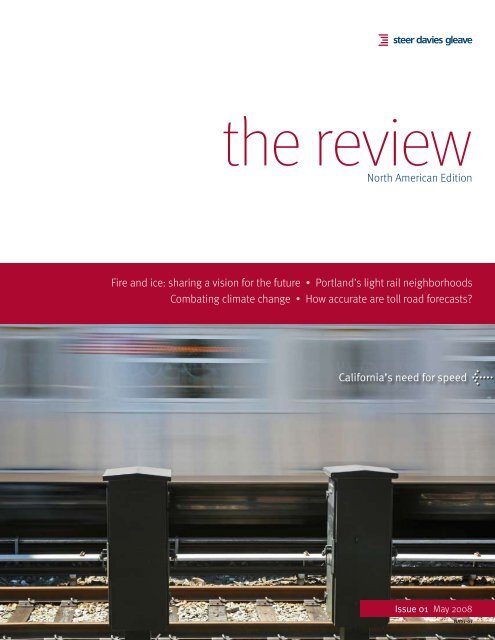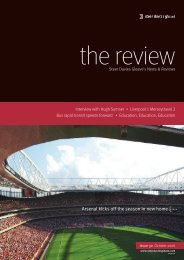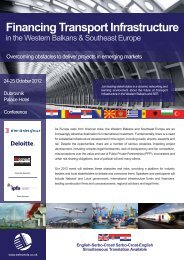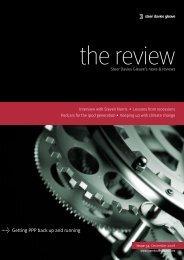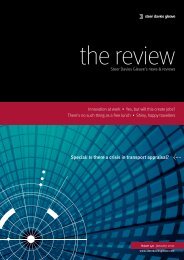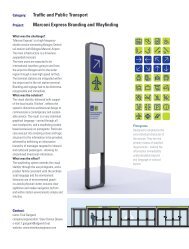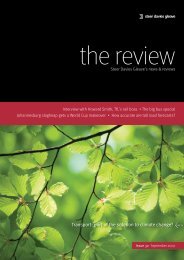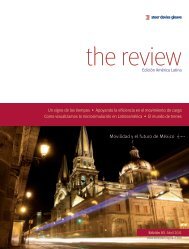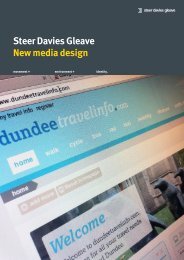California's need for speed - Steer Davies Gleave
California's need for speed - Steer Davies Gleave
California's need for speed - Steer Davies Gleave
You also want an ePaper? Increase the reach of your titles
YUMPU automatically turns print PDFs into web optimized ePapers that Google loves.
the review<br />
North American Edition<br />
Fire and ice: sharing a vision <strong>for</strong> the future • Portland’s light rail neighborhoods<br />
Combating climate change • How accurate are toll road <strong>for</strong>ecasts<br />
Cali<strong>for</strong>nia’s <strong>need</strong> <strong>for</strong> <strong>speed</strong><br />
Issue 01 May 2008<br />
NA01-01
Features<br />
tt Cali<strong>for</strong>nia’s <strong>need</strong> <strong>for</strong> <strong>speed</strong><br />
tt How accurate are toll road <strong>for</strong>ecasts<br />
tt Fire and ice: sharing a vision <strong>for</strong> the future<br />
tt Combating climate change<br />
tt Portland’s light rail neighborhoods<br />
Opening comment<br />
Welcome to our first North American edition<br />
of The Review. Over the past 30 years, <strong>Steer</strong><br />
<strong>Davies</strong> <strong>Gleave</strong> has built up a reputation as<br />
the UK’s premier transportation consulting<br />
business and now has a network of 13 offices<br />
around the world. With the opening of our<br />
New York office in January 2008 – our third<br />
office in North America – we felt it was time to<br />
produce a publication that better addressed<br />
the interests and <strong>need</strong>s of our North American<br />
partners and clients.<br />
And the timing couldn’t be better – 2008 is<br />
already proving to be an exciting year <strong>for</strong><br />
transportation in North America. On a global<br />
level, the issues are common: the role of<br />
transportation in combating and contributing<br />
to climate change, growing aspirations from<br />
users with regard to quality transit and the<br />
fundamental challenge of how to fund and<br />
finance important capital programs and<br />
ongoing operations. But nowhere else is the<br />
debate so critical as we watch the race <strong>for</strong> the<br />
White House with eagerness, the debate <strong>for</strong> the<br />
legacy of SAFETEA-LU, the implementation of<br />
the $37 billion Building Canada plan and the<br />
increasing role <strong>for</strong> public private partnerships.<br />
p2<br />
p4<br />
p5<br />
p6<br />
p7<br />
In this issue, we look at the key characteristics<br />
of a successful high <strong>speed</strong> line as Cali<strong>for</strong>nia<br />
considers whether it would be right <strong>for</strong> them,<br />
what transportation policies the UK is looking<br />
into to tackle climate change and a perspective<br />
on transit-oriented development, amongst<br />
other things.<br />
Cali<strong>for</strong>nia’s <strong>need</strong> <strong>for</strong> <strong>speed</strong><br />
By Richard Middleton<br />
The world is no stranger to high <strong>speed</strong> rail<br />
– it’s now been over 50 years since the first<br />
Shinkansen high <strong>speed</strong> rail line opened<br />
between Tokyo and Kyoto and Japan’s<br />
bullet trains have become renowned <strong>for</strong><br />
their <strong>speed</strong> and punctuality. Europe has<br />
also established an impressive network<br />
of high <strong>speed</strong> lines since the Paris to<br />
Lyon TGV began operating in 1981, and<br />
extensive expansion is continuing to<br />
spread rapidly throughout the continent.<br />
In the US, however, railroads never seemed<br />
to quite get back on track since their drastic<br />
decline in the 1950s and 60s and high <strong>speed</strong><br />
rail has certainly been a rare thought in the<br />
American transportation consciousness –<br />
until recently. A few weeks ago, Cali<strong>for</strong>nia’s<br />
governor Arnold Schwarzenegger hosted<br />
an in<strong>for</strong>mation day <strong>for</strong> the development of<br />
a high <strong>speed</strong> rail network. The proposed<br />
Cali<strong>for</strong>nian High Speed Rail (CHSR) network<br />
is a highly ambitious project, which would be<br />
funded through a public private partnership<br />
and cover some 1100 miles from Sacramento<br />
and San Francisco, down through Los<br />
Angeles to San Diego.<br />
With plans to operate at <strong>speed</strong>s of over<br />
200mph, the CHSR would be the first real<br />
high <strong>speed</strong> corridor in the United States.<br />
While the Northeast is also working on a<br />
fast line between Boston, New York and<br />
Washington DC, the North-East corridor is<br />
looking at maximizing the operational<br />
<strong>speed</strong> along an existing rail infrastructure<br />
rather than constructing a whole new<br />
railway alignment.<br />
<strong>Steer</strong> <strong>Davies</strong> <strong>Gleave</strong> has worked with both<br />
sponsors and operators of high <strong>speed</strong><br />
railways over the last 20 years and is<br />
currently providing input on the Portuguese<br />
and Italian systems. From our European<br />
experience, we have put together some of<br />
the key characteristics of a successful high<br />
<strong>speed</strong> line.<br />
Demography – ideally demand should be<br />
concentrated in a few high density cities,<br />
spaced some distance apart, with little in<br />
between to require the trains to slow down<br />
or stop. The Spanish network would be<br />
a good example. The linear nature of the<br />
Italian network, running down the ‘spine’<br />
of the country also benefits the design, by<br />
avoiding too many spur operations.<br />
The proposed Cali<strong>for</strong>nian route also runs<br />
predominantly north – south, connecting a<br />
number of very large centers of population.<br />
Recent work suggests this area is becoming<br />
a mega region (Planning <strong>for</strong> Megaregions –<br />
Journal of Planning Literature 2007); perhaps<br />
comparable with Tokyo-Osaka, another very<br />
successful high <strong>speed</strong> train route.<br />
Frequency – most high <strong>speed</strong> train corridors<br />
operate at high frequencies providing<br />
between 120-160 trains a day. These trains<br />
often provide capacities of 700-1,000 a train<br />
– operating both duplex and double train<br />
<strong>for</strong>mations.<br />
I hope that you find the material useful and<br />
stimulating and welcome your thoughts on<br />
the issues surrounding our industry.<br />
2<br />
Mike Goggin<br />
Head of North<br />
American Operations
News in brief<br />
Rail market share (%)<br />
Rail<br />
market<br />
share (%)<br />
This high capacity enables the operator to<br />
offer a number of different product offers<br />
on the same train and be competitive<br />
with other modes, typically air and<br />
conventional train in Europe. The proposed<br />
Cali<strong>for</strong>nian operation compares well with<br />
this approach with 128 trains a day in each<br />
direction being proposed <strong>for</strong> the corridor;<br />
operating up to 1,100 seats a train.<br />
Competition – as mentioned, air and<br />
conventional rail are the main competitors<br />
to high <strong>speed</strong> rail; with conventional rail<br />
virtually non existent in Cali<strong>for</strong>nia, it will<br />
be interesting to see how the new<br />
services impact on a very entrenched<br />
and professional air market. The table<br />
below shows the increases in market<br />
share achieved by a number of high<br />
<strong>speed</strong> introductions. Traditionally high<br />
<strong>speed</strong> introductions have seen little transfer<br />
from the car market. This might be different<br />
in Cali<strong>for</strong>nia, especially with the introduction<br />
of strong environmental legislation of the<br />
same period.<br />
100%<br />
90%<br />
80%<br />
70%<br />
60%<br />
50%<br />
40%<br />
30%<br />
20%<br />
10%<br />
0%<br />
Frankfurt-Cologne<br />
London - Manchester<br />
London - Brussels<br />
Madrid - Seville<br />
London - Paris<br />
Paris - Maeseille<br />
Madrid - Barcelona<br />
00:00 01:00 02:00 03:00 04:00 05:00 06:00 07:00 08:00<br />
Rail journey time<br />
Rome- Milan<br />
Cost – costs of high <strong>speed</strong> rail (186+mph)<br />
100%<br />
has come down Frankf urt-Cologne in recent years, with both<br />
90%<br />
Spain and France Madrid-Seville achieving a construction<br />
80%<br />
London-Manchest er London-Paris<br />
cost 70% of under $10million per mile <strong>for</strong> their<br />
Pari s-Marsei lle<br />
60%<br />
London-Brus sels<br />
latest schemes.<br />
However, tunnels and viaducts probably<br />
increase the cost by a factor of up to five<br />
and steep gradients also increases cost,<br />
as does movement though urban areas. In<br />
fact, some recent schemes have chosen to<br />
run underground rather than disturb major<br />
urban areas, an example of this would be<br />
the High Speed 2 link into London.<br />
Risks – because risks vary with the<br />
different stages in the development of a<br />
high <strong>speed</strong> scheme, it is essential that<br />
the various risks are assigned to the<br />
party (public or private) that is in the best<br />
position to handle that risk. Construction<br />
risk all but disappears once the line is<br />
operational (except <strong>for</strong> residual defects);<br />
demand and revenue risk reduces over<br />
time as a history is built up of actual<br />
service; while operation risk continues the<br />
length of the concession and might even<br />
be the subject of sharp peaks, <strong>for</strong> example<br />
if a new generation of trains is introduced.<br />
Cali<strong>for</strong>nia will be holding a referendum in<br />
November this year as to whether it should<br />
proceed with the development of its high<br />
<strong>speed</strong> network at this time. If successful,<br />
<strong>Steer</strong> <strong>Davies</strong> <strong>Gleave</strong> will be looking <strong>for</strong>ward<br />
to playing an active role in its development<br />
over the next decade.<br />
An expert in railways, Richard leads SDG’s<br />
rail projects outside the UK, in particular<br />
supporting operators, investors and<br />
government sponsors in the restructuring<br />
and commercial development of the<br />
industry and in developing, bidding and<br />
awarding rail concessions and franchises.<br />
To find out more or discuss further contact<br />
richard.middleton@sdgworld.net<br />
Peering into Ottawa’s future<br />
<strong>Steer</strong> <strong>Davies</strong> <strong>Gleave</strong> is taking part in a peer<br />
review panel to look at Ottawa’s long-term<br />
transit investment plans that will help shape<br />
the city’s future. While the peer review<br />
initially examined proposals to upgrade<br />
the city’s current busway system, the panel<br />
has posed a series of key challenges <strong>for</strong> the<br />
city that go beyond a ‘transit only’ review.<br />
Looking out to 2031, the panel wanted<br />
a clearer view of what role Ottawa would<br />
have as a 21st century capital city and has<br />
recommended a concentration on higher<br />
density, more sustainable land use within the<br />
existing Green Belt, supported by the busway<br />
being upgraded to light rail, including an<br />
extension to serve the international airport. A<br />
fully integrated network would also see major<br />
investment in bus and streetcar systems.<br />
All go in Atlanta<br />
Host of the 1996 Olympics and the world<br />
headquarters of Coca Cola, Atlanta is<br />
developing a long-term transportation<br />
plan as part of its aim to be one of North<br />
America’s premier cities. <strong>Steer</strong> <strong>Davies</strong> <strong>Gleave</strong><br />
is bringing our European/World experience<br />
and expertise in evaluation methodologies<br />
to the project. Our input has covered the<br />
latest innovations in transit and an emphasis<br />
on integrated solutions incorporating<br />
transit investment, transportation demand<br />
management and stronger links to<br />
sustainable land use policies. We will also<br />
be advising on comprehensive, multi-modal<br />
strategy evaluation techniques as the<br />
strategy work develops.<br />
The carbon calculator<br />
It is clear that minimizing CO 2<br />
emissions<br />
and impacts on climate change is becoming<br />
a bigger priority <strong>for</strong> organizations around<br />
the world. <strong>Steer</strong> <strong>Davies</strong> <strong>Gleave</strong> recently<br />
developed a ‘carbon calculator’ <strong>for</strong> the<br />
European Bank <strong>for</strong> Reconstruction and<br />
Development to determine CO 2<br />
emissions<br />
from potential local transportation projects.<br />
The calculator was developed by classifying<br />
potential transportation investments,<br />
including bus fleets and tram/light-rail<br />
systems. They were assessed based on<br />
the degree to which the investment would<br />
encourage individuals to use their cars less,<br />
in favor of more sustainable modes of travel.<br />
3
How accurate are<br />
toll road <strong>for</strong>ecasts<br />
By Anita Mauchan and Charles Russell<br />
Planners and decision makers have always<br />
<strong>need</strong>ed traffic <strong>for</strong>ecasts – they relied on<br />
good analysis to develop their plans and<br />
determine what new infrastructure should<br />
be built. But what was the penalty if their<br />
<strong>for</strong>ecasts were wrong Now, with private<br />
investment decisions depending on traffic<br />
and revenue projections, the pressure has<br />
surely changed.<br />
<strong>Steer</strong> <strong>Davies</strong> <strong>Gleave</strong> regularly prepares<br />
traffic demand and revenue <strong>for</strong>ecasts <strong>for</strong><br />
privately funded infrastructure projects,<br />
especially toll roads, tunnels and bridges.<br />
We acknowledge that predicting the future<br />
isn’t easy and consequently, although<br />
deriving a view of the future is a key<br />
aspect of the work, equal ef<strong>for</strong>t is put into<br />
quantifying areas of uncertainty and risk.<br />
A few years ago, there was real concern<br />
when ratings agency Standard and Poor’s<br />
published a paper claiming that traffic<br />
levels on toll roads are typically over<br />
<strong>for</strong>ecast by 20-30%, which they attributed<br />
to a clear case of “optimism bias”.<br />
While we had never <strong>for</strong>mally reviewed<br />
our <strong>for</strong>ecasts, feedback from clients<br />
didn’t match this finding. There was only<br />
one thing to do. We carried out our own<br />
research to determine the accuracy of our<br />
toll road <strong>for</strong>ecasts.<br />
Frequency<br />
There were four factors, however, that<br />
didn’t make it as simple as it sounds:<br />
Client confidentiality – our reporting<br />
must be general and can’t reveal specific<br />
schemes or figures.<br />
Scheme definition – opening dates and even<br />
toll levels and categories are all subject to<br />
change post-<strong>for</strong>ecast.<br />
Which <strong>for</strong>ecasts – our <strong>for</strong>ecasts reflect<br />
different levels of probability, the values<br />
adopted are ultimately the choice of our<br />
client and may not represent what we believe<br />
to be a most likely outcome.<br />
Ramp up – it may take time <strong>for</strong> users to<br />
adjust to new or changed routes and this can<br />
be enhanced by delayed opening of sections<br />
etc. Comparison of <strong>for</strong>ecast and actual traffic<br />
(outturn) should be undertaken once the<br />
system has settled down.<br />
Despite these challenges, we have<br />
established a library of <strong>for</strong>ecasts and<br />
outturn traffic and revenue values.<br />
Using this data, we assessed the accuracy<br />
of our <strong>for</strong>ecasts and learned some<br />
valuable lessons.<br />
Our research findings<br />
The following comparison of <strong>for</strong>ecasts and<br />
actual traffic provide a broad indication<br />
of our track record <strong>for</strong> schemes in which<br />
outturn data are available.<br />
Our research data is based on <strong>for</strong>ecasts <strong>for</strong><br />
seven shadow toll roads in the UK and user<br />
paid toll roads in Canada, Jamaica, South<br />
Africa and Poland.<br />
10 9876543210<br />
9<br />
3<br />
2<br />
0<br />
1<br />
0.8 0.9 1 1.1 1.2<br />
Actual / Forecast Traffic<br />
The results are tabulated in the figure below<br />
which compares outturn and <strong>for</strong>ecast traffic<br />
on these 15 examples, where, importantly<br />
‘ramp-up’ was considered to be complete.<br />
We over-predicted by more than 5% in<br />
one case, we were within 5% of outturn<br />
in nine and we under-predicted by more<br />
than 5% in five cases. The only scheme<br />
that underper<strong>for</strong>med was influenced by an<br />
unexpected external factor. The majority<br />
of schemes that we under-<strong>for</strong>ecast were<br />
affected by a post-<strong>for</strong>ecast toll reduction<br />
which resulted in higher traffic flows.<br />
The accuracy of our <strong>for</strong>ecasts <strong>for</strong> two<br />
toll roads in South Africa has also been<br />
investigated by MTH Pycraft and I Macaulay<br />
in their paper Demand Forecasting Risk in<br />
Project Financing of Toll Facilities, University<br />
of Witswatersrand (2006). With reference<br />
to Standard & Poor’s paper, the authors<br />
concluded that:<br />
“The South African user-paid toll roads<br />
scheduled per<strong>for</strong>mance [ratio of actual<br />
traffic volume to <strong>for</strong>ecast traffic volume] is<br />
significantly greater or better than not only the<br />
entire world results, but also the developing<br />
nations scheduled per<strong>for</strong>mance results.”<br />
In light of both these results, we are<br />
confident that we deliver accurate <strong>for</strong>ecasts<br />
and a clear analysis of uncertainty and risk.<br />
We will continue to update the database of<br />
research, drawing on our findings to improve<br />
our understanding of the demand <strong>for</strong> toll<br />
facilities worldwide and are grateful <strong>for</strong> the<br />
support our clients have given in assisting us<br />
with this analysis.<br />
Charles leads our infrastructure finance<br />
team. His main focus is in the US where we<br />
have advised on more than 20 transport<br />
infrastructure projects in the last three years,<br />
valuing $50 billion. Anita leads our work in<br />
this area in Europe and Africa.<br />
To find out more or discuss further contact<br />
charles.russell@sdgworld.net<br />
anita.mauchan@sdgworld.net<br />
4
Fire and ice: Sacramento and<br />
Edmonton share a vision <strong>for</strong> the future<br />
By Alan Jones<br />
It’s a tale of two cities. Sacramento,<br />
Cali<strong>for</strong>nia’s state capital, has a moderate<br />
climate but its summers can easily reach<br />
over 100F degrees. A thousand miles<br />
north in Edmonton, Alberta’s capital,<br />
temperatures can drop to as low as -40F<br />
degrees in the winter.<br />
Despite these differences, both cities are<br />
facing very similar challenges regarding the<br />
future shape and <strong>for</strong>m of their land use,<br />
and deciding how transit can play a part in<br />
delivering a ‘smart growth’ future as they<br />
anticipate continuing concerns of climate<br />
change, greenhouse gas emissions, energy<br />
prices and growing but aging populations.<br />
<strong>Steer</strong> <strong>Davies</strong> <strong>Gleave</strong> is working with both<br />
cities developing their long-term transit<br />
plans. In Sacramento the region has made<br />
a major ef<strong>for</strong>t to develop a 50 year land<br />
use plan. Known as The Blueprint, the plan<br />
is based on smart growth principles with<br />
mixed use, higher density development and<br />
greater transportation choice. To support<br />
The Blueprint we are developing a long-term<br />
Transit Master Plan (TMP) which will address<br />
all aspects of the existing transit network.<br />
Sacramento already has an enviable LRT<br />
system with extensions and new lines being<br />
planned. In addition, its bus fleet is<br />
CNG-powered so there is already much to<br />
build on. However, with a market share of<br />
just 1%, there is still a long way to go in<br />
changing the perceptions of what transit can<br />
deliver and shift the thinking from it as a<br />
lifeline service to a lifestyle choice. This is<br />
where a European-style approach can help<br />
produce an integrated solution. Addressing<br />
the basics, we start by “putting the<br />
passenger first”.<br />
Service frequencies and coverage are<br />
being examined alongside a consideration<br />
of the whole transit trip: where do I find<br />
transit in<strong>for</strong>mation on routes and fares,<br />
how do I get to the transit stop, how long<br />
will I have to wait, do I <strong>need</strong> exact fare, can<br />
I get a seat, do I feel safe, is it com<strong>for</strong>table,<br />
will I <strong>need</strong> to transfer and how do I get to<br />
my final destination and back again<br />
With so many barriers it is often just easier<br />
to drive. But in answering these questions<br />
we start to build a convenient and friendly<br />
transit system with up-to-date in<strong>for</strong>mation;<br />
high quality, frequency and capacity<br />
across all transit modes; easy-to-use fares<br />
systems; easy access vehicles and helpful<br />
way-finding linked to key destinations.<br />
The links between land use and transit<br />
investment are also key to the future<br />
with transit-oriented development (TOD)<br />
policies central to the TMP.<br />
In Edmonton similar conditions apply. The<br />
city already has an LRT system as its transit<br />
backbone, with extensions to the early<br />
1980’s system now underway. But Edmonton<br />
has bigger plans <strong>for</strong> transit after 25 years of<br />
car-oriented, low density development. Five<br />
new LRT corridors are being planned with the<br />
Mayor’s call <strong>for</strong> a 90-day Action Plan driving<br />
the process <strong>for</strong>ward.<br />
<strong>Steer</strong> <strong>Davies</strong> <strong>Gleave</strong> is developing<br />
Edmonton’s long-term public<br />
transportation plan incorporating the LRT<br />
Expansion Plan as well as a major review of<br />
the city’s bus network. The links with land<br />
use again feature in the development of<br />
the transit plan.<br />
A TOD Planning Framework is being<br />
developed with a range of station types<br />
being defined to help shape the land use<br />
around each new station. Complete streets<br />
are also being proposed <strong>for</strong> high frequency<br />
bus corridors providing active frontages,<br />
footways and bike facilities.<br />
A recent design charrette focused on a<br />
new development area in Heritage Valley,<br />
a green-field site to the south of the<br />
city where LRT is planned. The charrette<br />
brought together city staff from planning,<br />
engineering, smarter choices, parks, traffic,<br />
transportation and transit together with<br />
land owners, developers, school board and<br />
Alberta Province representatives.<br />
Over three days all the participants<br />
contributed, moving from the original plan<br />
<strong>for</strong> a car-dominated town centre plan to an<br />
urban grid layout designed with the LRT<br />
station as a focal point. This finer grain<br />
street pattern provides wide sidewalks and<br />
active building frontages, encouraging a<br />
more interesting and higher value mix of<br />
land uses. The charrette allowed us to test<br />
the emerging TOD Planning Framework and<br />
acted as a “decision accelerator”. If all the<br />
participants follow through with the new<br />
plan then Edmonton will be on its way to a<br />
new, more transit-friendly future.<br />
Alan has over 25 years’ experience leading<br />
multi-disciplinary planning and design<br />
teams to deliver high-quality integrated<br />
transport solutions.<br />
To find out more or discuss further contact<br />
alan.jones@sdgworld.net<br />
ian.druce@sdgworld.net<br />
dan.gomez-duran@sdgworld.net<br />
5
News in brief<br />
Combating climate<br />
change: a perspective<br />
from the UK<br />
By Chris Ferrary<br />
Same question, different perspectives<br />
Over the past year, <strong>Steer</strong> <strong>Davies</strong> <strong>Gleave</strong><br />
has advised the Department of Treasury of<br />
New Jersey on the potential monetization<br />
of its toll road assets. We are now working<br />
to advise lenders in connection with the<br />
acquisition of the Pennsylvania Turnpike. The<br />
question <strong>for</strong> the sell side and the buy side is<br />
essentially the same: What’s it worth $20,<br />
$30, $60 billion<br />
Bidding hello to TransTexas corridors<br />
Principal Consultant Fintan Geraghty has<br />
just completed a two-month secondment to<br />
Zachry American Infrastructure’s (ZAI) offices<br />
in San Antonio. Leading a team of <strong>Steer</strong><br />
<strong>Davies</strong> <strong>Gleave</strong> staff, he has been helping<br />
ZAI/ACS prepare their bid <strong>for</strong> the TTC69<br />
development program.<br />
Linking Las Vegas<br />
The Las Vegas Monorail is one of very few<br />
fully private transit systems – certainly in the<br />
US. Principal Consultant Maarten Kroes has<br />
been working closely with the management<br />
helping them explore how changes in their<br />
ticket offer might impact their patronage<br />
and their revenue.<br />
Looking <strong>for</strong>ward<br />
It’s one step <strong>for</strong>ward and one step back <strong>for</strong><br />
P3 toll roads. The moratorium in Texas, and<br />
the recent Supreme Court decision in Virginia,<br />
might suggest that the program is running<br />
out of steam. But Florida, North Carolina –<br />
and Texas – are still bringing projects to the<br />
market. <strong>Steer</strong> <strong>Davies</strong> <strong>Gleave</strong> is supporting<br />
clients in these and other markets.<br />
While the debate in North America<br />
continues over what contribution transit<br />
can make to the national climate change<br />
agenda, the discussion has moved on in<br />
the UK. Over the past year <strong>Steer</strong> <strong>Davies</strong><br />
<strong>Gleave</strong> has encountered unprecedented<br />
interest from UK clients wanting to better<br />
understand the impacts of their travel to<br />
climate change and how to reduce them.<br />
Across business, industry and government,<br />
organizations are beginning to see<br />
the importance of reducing global CO 2<br />
emissions from both an ethical and a<br />
business standpoint. The UK transportation<br />
sector, however, has been relatively slow<br />
to respond. In 2004, CO 2<br />
emissions from<br />
the UK overall were almost 20% lower than<br />
in 1970, and emissions from industry were<br />
almost half what they had been. Much of<br />
this was due to economic restructuring,<br />
but many process industries made great<br />
strides in energy efficiency and emissions<br />
reduction over this time.<br />
By contrast, even excluding aviation, CO 2<br />
emissions from transportation doubled over<br />
the same period. Even now, transportation<br />
is the only sector of the UK economy where<br />
carbon emissions continue to grow and are<br />
projected to be higher in 2020 than they<br />
were in 1990. Transportation policy <strong>need</strong>s<br />
to play a central part if there is going to be a<br />
real difference in climate change.<br />
However, tackling transportation<br />
emissions is especially challenging<br />
because of our absolute dependence on<br />
fossil fuels to move ourselves and our<br />
goods around: 99% of all UK transportation<br />
use oil products. And while the use of<br />
alternative fuels is increasing, there are<br />
profound difficulties in finding alternatives<br />
to oil in aviation, shipping and longdistance<br />
road transportation. 95% of all<br />
goods in shops currently get there using<br />
oil, making it difficult to decouple CO 2<br />
emissions in the transportation sector<br />
from economic growth.<br />
There is a growing realization of the depth<br />
of this problem and there seems to be a real<br />
appetite to address it, but new approaches<br />
are <strong>need</strong>ed. <strong>Steer</strong> <strong>Davies</strong> <strong>Gleave</strong> is<br />
developing ways to deal better with this<br />
problem based on the following framework.<br />
Understand the problem: All too often,<br />
policy-makers simply don’t know what the<br />
carbon impacts of the proposals they put<br />
<strong>for</strong>ward are, this has to be the starting point<br />
<strong>for</strong> managing and reducing emissions.<br />
Identify carbon targets/budgets and<br />
the responses required to meet them:<br />
Developing ‘carbon-friendly’ policies,<br />
without knowing what we are aiming<br />
<strong>for</strong> first typically results in a package of<br />
ineffective measures.<br />
Understand the limits of technology: Fuel<br />
efficiency and alternative fuels can help,<br />
but are not the panacea as some believe.<br />
A clear vision of what else is <strong>need</strong>ed to<br />
combat the problem is also necessary.<br />
Understand the role of behavior change:<br />
There is increasing evidence that personal<br />
travel planning can be at least as<br />
important, if not more, than technology in<br />
reducing emissions.<br />
Implementing and selling the policies:<br />
Policies have to be packaged and sold to<br />
politicians and the public alike in terms<br />
of what <strong>need</strong>s to be done to avoid climate<br />
change catastrophe.<br />
Measuring and monitoring: We <strong>need</strong> to<br />
show that the policies we choose are<br />
working, and that we are actively moving<br />
towards meeting the targets that are set.<br />
Chris Ferrary is an expert in environmental<br />
and climate change consultancy with over<br />
30 years’ experience.<br />
To find out more or discuss further contact<br />
chris.ferrary@sdgworld.net<br />
6
Maxing the MAX: developing<br />
Portland’s light rail neighborhoods<br />
By Alan Jones<br />
Portland is widely known <strong>for</strong> its<br />
commitment to developing a sustainable<br />
urban <strong>for</strong>m, achieved through its Urban<br />
Growth Boundary, a commitment to<br />
regenerating its downtown area and major<br />
investment in the Metropolitan Area<br />
Express (MAX) light rail network, and more<br />
recently its streetcar system.<br />
As the MAX Light Rail network continues<br />
to expand with the construction of a new<br />
‘Green Line’ well under way, <strong>Steer</strong> <strong>Davies</strong><br />
<strong>Gleave</strong> has been brought in by the City<br />
of Portland to develop detailed Station<br />
Area Plans <strong>for</strong> two of the intermediate<br />
stops on the line at Division Street and<br />
Powell Boulevard. However, because both<br />
stations are located in areas featuring a<br />
suburban post 1950’s development <strong>for</strong>m,<br />
the low-density layout means that they<br />
are not within easily walkable distances<br />
and a range of solutions is <strong>need</strong>ed to<br />
address this challenge.<br />
Our approach, dubbed “Maxing the MAX”,<br />
has taken a fresh look at the scope to deploy<br />
transit-oriented development techniques to<br />
increase the ridership of the new MAX line,<br />
and maximize the benefits of the new transit<br />
investment <strong>for</strong> the local communities. A<br />
design charrette was used to hear the views<br />
of Portland’s Department of Transport (DoT),<br />
Metro, TriMet and the Portland Development<br />
Commission. Working with sub-consultants<br />
Glatting Jackson, we developed a series of<br />
proposals that ranged from immediate lowcost<br />
improvements through to a long-term<br />
vision <strong>for</strong> each station area.<br />
With the Green Line constructed within the<br />
I-205 freeway right of way, we have focused<br />
short-term improvements on improving<br />
safety <strong>for</strong> transit riders and improving<br />
transfer between existing bus routes and<br />
the new Light Rail system. The next stage<br />
involves developing a network of 10-<br />
minute walk and bike routes with solutions<br />
including a new bridge (pedestrian and bike<br />
only) across the freeway to provide easy<br />
access from local neighborhoods.<br />
Looking at the longer term, we have<br />
proposed a program of street changes,<br />
with wider footways and ‘traffic calming’<br />
techniques, to change the feel of the<br />
station areas – while they will not become<br />
totally car-free, they will at least not be a<br />
car free-<strong>for</strong>-all.<br />
Looking further into the future, redundant<br />
land owned by the Oregon DoT within<br />
the freeway right of way is also being<br />
reviewed to add to the station area plans<br />
and their aim of creating walkable urban<br />
areas within easy access to MAX. Our<br />
approach to station area development has<br />
also looked at new funding mechanisms,<br />
which would be applicable across the<br />
MAX network as Portland looks to develop<br />
sustainable neighborhoods around other<br />
MAX stations, and enhancing the quality of<br />
life <strong>for</strong> those communities.<br />
To find out more or discuss further contact<br />
alan.jones@sdgworld.net<br />
ian.druce@sdgworld.net<br />
7
Our locations<br />
USA<br />
59th Floor, Empire State Building<br />
350 Fifth Avenue, New York NY 10118<br />
t +1 212 601 1966<br />
e usainfo@sdgworld.net<br />
Canada<br />
1000–355 Burrard Street<br />
Vancouver BC, V6C 2G8<br />
t +1 (604) 608 6198<br />
e canadainfo@sdgworld.net<br />
Chile<br />
Mariano Sanchez Fontecilla 310<br />
Piso 16, Santiago<br />
t +56 (0)2 473 6900<br />
e chileinfo@sdgworld.net<br />
Colombia<br />
Carrera 7, No. 71–21 Torre A<br />
Oficina 604 Edi>cio Av. Chile, Bogotá<br />
t +57 1 317 3231<br />
e colombiainfo@sdgworld.net<br />
Puerto Rico<br />
1606 Ponce de León Av. Suite #500,<br />
San Juan, Puerto Rico 00909<br />
t +1 787 (0)721 2002<br />
e puertoricoinfo@sdgworld.net<br />
About us<br />
England<br />
lo n d o n<br />
28–32 Upper Ground<br />
London SE1 9PD<br />
t +44 (0)20 7910 5000<br />
e sdginfo@sdgworld.net<br />
leeds<br />
West Riding House<br />
67 Albion Street<br />
Leeds LS1 5AA<br />
t +44 (0)113 389 6400<br />
e leedsinfo@sdgworld.net<br />
Scotland<br />
e d i n b u r g h<br />
68–70 George Street<br />
Edinburgh EH2 2LR<br />
t +44 (0)131 226 9500<br />
e edinburghinfo@sdgworld.net<br />
g l a s g o w<br />
3rd Floor Ingram House<br />
227 Ingram Street<br />
Glasgow G1 1DA<br />
t +44 (0)141 224 0990<br />
e glasgowinfo@sdgworld.net<br />
France<br />
11 Rue de Pontel<br />
78100 Saint Germaine en Laye,<br />
Paris<br />
t +33 (0)684 670 493<br />
e franceinfo@sdgworld.net<br />
Italy<br />
b o lo g n a<br />
Via Ugo Bassi 7, 40121 Bologna<br />
t +39 051 656 9381<br />
e italyinfo@sdgworld.net<br />
r o m e<br />
c/o REGUS<br />
Via Salandra, 18<br />
00187 Rome<br />
t +39 06 42272243<br />
e italyinfo@sdgworld.net<br />
Spain<br />
Calle Sagasta 26 6 izquierda<br />
28004 Madrid<br />
t +34 91 541 8696<br />
e spaininfo@sdgworld.net<br />
<strong>Steer</strong> <strong>Davies</strong> <strong>Gleave</strong> is a leading<br />
independent transportation<br />
management consultancy providing<br />
services to government, operators,<br />
regulators, promoters, financiers and<br />
other interest groups. Founded 30 years<br />
ago and with more than 350 consultants<br />
worldwide, we have an unparalleled<br />
breadth of specialist expertise available<br />
<strong>for</strong> our clients. We welcome the<br />
opportunity <strong>for</strong> an in<strong>for</strong>mal discussion<br />
on prospective consulting assignments.<br />
Contact us at sdginfo@sdgworld.net<br />
Considering your career<br />
We are always looking <strong>for</strong> gifted, motivated individuals <strong>for</strong> roles in all parts of<br />
the company, in all parts of the world. If you are considering your future and are<br />
looking <strong>for</strong> somewhere to make a real difference, <strong>Steer</strong> <strong>Davies</strong> <strong>Gleave</strong> has much<br />
to offer. Visit www.steerdaviesgleave.com or email careers@sdgworld.net<br />
Printed using environmentally responsible<br />
waterless print process with vegetable based inks<br />
and by print production systems that are registered<br />
to ISO14000:2004, ISO9001:2000 and EMAS<br />
standards.<br />
Staff profile<br />
Eva Hage<br />
Associate<br />
Eva is a senior business<br />
advisor and management<br />
consultant with extensive<br />
experience in assisting clients with<br />
economic appraisal and financing of<br />
major capital projects. Her clients include<br />
companies in the transport, real estate,<br />
utility, finance and public sectors.<br />
What made you decide to work in<br />
transport consultancy Like many things<br />
in life, it was decided <strong>for</strong> me. When I moved<br />
to Vancouver I got a job at a government<br />
agency overseeing the development of<br />
strategic and business plans at Crown<br />
Corporations (corporations owned by the<br />
provincial government). Mine happened<br />
to be the transportation corporations and I<br />
have continued working with transportation<br />
issues from various perspectives, mainly<br />
financial, ever since.<br />
What is the best thing about your job<br />
Constantly learning new things. and meeting<br />
people from all over the world.<br />
What would you do if you weren’t<br />
working in transportation consultancy<br />
Hhmm. It is a toss up between building<br />
furniture and running my own nursery<br />
(<strong>for</strong> plants).<br />
What couldn’t you live without<br />
Coffee.<br />
What do you think is the biggest<br />
challenge facing the transportation<br />
industry today Rising fuel prices and<br />
increased congestion in cities means that<br />
we can no longer go about our lives the way<br />
we used to – and finding new alternatives<br />
means changing the way we live, work, plan<br />
our cities, how we get around and even<br />
down to how we interact with family and<br />
friends. Transportation affects every facet of<br />
life, and that is what makes it a fascinating<br />
field to work in.<br />
What is the best advice you have<br />
ever received Smile.<br />
Who do you most admire and why<br />
My husband <strong>for</strong> his insights, humour<br />
and integrity.


